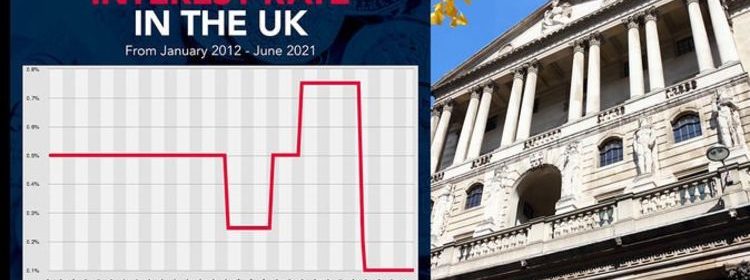Interest rates chart: Full history of UK borrowing rates as Bank of England to make update

Bank of England: Victoria Scholar discusses interest rates
We use your sign-up to provide content in ways you’ve consented to and to improve our understanding of you. This may include adverts from us and 3rd parties based on our understanding. You can unsubscribe at any time. More info
The Monetary Policy Committee (MPC) will today set the Bank of England’s base rate in an announcement later this morning. The figure is expected to rise to 0.25 percent, up 0.15 percent on the current rate, spelling the end of the lowest borrowing rate the UK has ever seen.
On March 19, 2020, ahead of the first coronavirus lockdown, the Bank of England changed the interest base rate to a historic low of 0.1 percent.
The move was made to support the economy during the coronavirus pandemic – meaning mortgage and credit card borrowing rates hit an all-time low.
The rise is caused by the heightened rate of inflation, which has been exacerbated by the emergence from lockdown’s world over and widespread global supply chain issues.
But how has the rate changed over the years? Express.co.uk takes a look at the BoE’s changing rates since 2010.
READ MORE: Interest rates to rise this week: What it means for YOU and your money

The history of interest rates – explained
Recent history of the UK’s interest rate demonstrates how low the current rate is.
During 2003 to 2007, the interest rate rose significantly to curb an over-inflating economy.
In July 2003, the interest rate was at 3.5 percent and went as high as up to 5.75 percent in July 2007.

The global financial crisis of 2008 has since kept rates under six percent.
The rate fell dramatically from 5.75 percent in July 2007 to a mere 0.5 percent by March 2009.
The Bank of England said: “During the financial crisis of 2008, people reduced their spending and many lost their jobs. We had to cut interest rates to really low levels to support spending and jobs.
“Over the past few years, our economy has needed interest rates to stay very low.”
DON’T MISS
Interest rates LIVE: 10m Britons face mortgage squeeze [INSIGHT]
Interest rate hike to give pensioners £5,000 extra income [REPORT]
Carney blasted over ‘not enough money in world’ claim [INSIGHT]
Interest rates fell even further in August 2016 to just 0.25 percent, rising again to 0.5 percent in November 2017, then settling on 0.75 percent in August 2018.
The flagship interest rate has been below one percent since 2009, following the 2008 financial crash.
Homebuyers have enjoyed the remarkably low rate throughout the pandemic, which has seen house prices soar exponentially.
The average UK home is now worth more than £250,000 according to data released this week – the first time in history.
Source: Read Full Article
